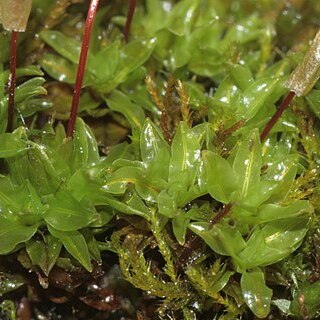Plants medium-sized, forming cushions, green; saxicolous. Stems 5-20 mm, radicu-lose below; in section round, central strand present, inner cortical cells medium-sized, thin-walled, in 5-6 rows, outer cortical cells smaller, in 2 rows, reddish. Leaves erect with lamina inrolled dry, widespreading wet; lingulate to elliptical, 3-4 mm long; apex acute to mucronate, frequently cucullate; base oblong; margins plane, papillose. Costa ending below apex or percurrent, ventral superficial cells quadrate, papillose, similar to laminal cells, dorsal superficial cells elongate, smooth; in section guide cells 4, large, with several dorsal supplementary cells, ventral cells in 2-3 rows, large, weakly thickened, ventral surface cells smaller, papillose, dorsal stereid band strong, in 4-5 rows, dorsal surface cells undifferentiated, smooth. Upper laminal cells quadrate to hexagonal, weakly thickened, papillae 1-4, large, C-or O-shaped; basal cells highly differentiated, fragile, rectangular, vertical walls thin, end walls thickened, reddish; basal marginal cells linear, thickened, forming distinct borders 5 cells wide. Autoicous. Perichaetia terminal, leaves short, spathulate-obovate, apex obtuse. Seta 6 mm long, red-brown; capsule cylindrical, 2.5-3.0 mm long, yellow-brown, exothecial cells rhomboidal to quadrate, thin-walled; peristome absent; operculum long-rostrate, to 2 mm high; calyptra cylindrical-rostrate, 5.0-5.5 mm long, entire to erose at base; spores with prominent tetrad scar, 34-37 µm, distal surface warty, red-yellow.
More
Stems 5-20 mm, central strand small. Leaves broadly oblong to lingulate, 3-4 mm; apices broadly acute to obtuse, sometimes weakly cucullate or muticous; margins plane or weakly incurved; costa subpercurrent or percurrent, papillose; laminal cells 8-14 µm; basal cells smooth. Specialized asexual reproduction absent. Seta 4-8 mm, yellowish red. Capsule exserted, erect, cylindric, 2-3.5 mm, weakly straight-furrowed, yellowish brown, exothecial cells rectangular, walls weakly thickened; peristome absent or just a short hyaline membrane present; operculum 1.5 mm. Calyptra 4-5 mm, base not fringed, body smooth or papillose above or throughout. Spores 22-35 µm, warty, light brown.

